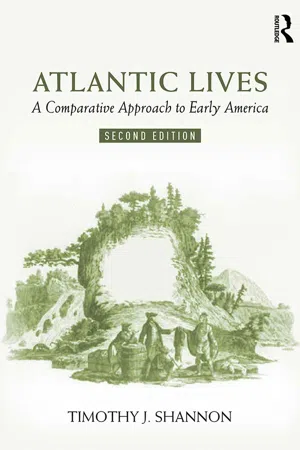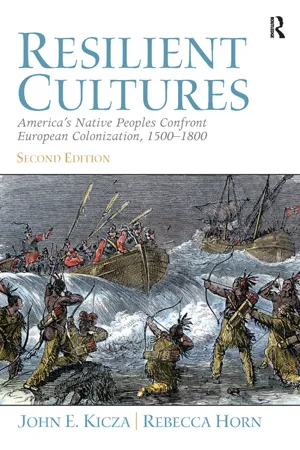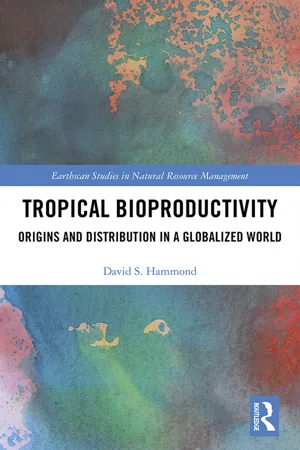History
Columbian Exchange
The Columbian Exchange refers to the widespread transfer of plants, animals, culture, human populations, technology, and ideas between the Americas and the Old World following Christopher Columbus's voyages to the Americas in 1492. This exchange had a profound impact on both the New and Old Worlds, leading to significant cultural, ecological, and economic changes.
Written by Perlego with AI-assistance
Related key terms
6 Key excerpts on "Columbian Exchange"
- eBook - ePub
Atlantic Lives
A Comparative Approach to Early America
- Timothy Shannon(Author)
- 2019(Publication Date)
- Routledge(Publisher)
2 The Columbian ExchangeFigure 2.1 Smallpox among the Nahuatl in Sixteenth-Century Mexico.Of the many diseases transmitted across the Atlantic in the Columbian Exchange, smallpox was the most deadly for Native Americans (see Selection 2). Considered a childhood disease in Europe, in America it led to fatality rates that ranged from 30 to 90 percent of infected populations. This image of Native Americans suffering from smallpox comes from a sixteenth-century Spanish collection about the Aztecs.Source: Florentine Codex, Book XII folio 54. Bernardino de Sahagún, Historia general de las cosas de la Nueva España (1540–1585).Introduction
The passage of human beings between the Old World and the New led to a much wider transfer of plant and animal life commonly known as the Columbian Exchange. Some of this exchange occurred by design, such as when Old World farmers planted American crops in their fields; other times, the exchange was inadvertent, such as when colonists unwittingly introduced new diseases to Native American populations. Whether purposeful or accidental, such exchanges forever altered the nature of plant, animal, and human life on both sides of the Atlantic. Formerly isolated ecosystems became intertwined and transformed in the process. Some species experienced extinction or near extinction, while others flourished in new surroundings unchecked by natural enemies. While scholars have typically studied the human actors involved in this drama, we cannot appreciate the full impact of the Columbian Exchange without considering the other forms of life it affected.The most profound changes wrought by the Columbian Exchange resulted from the transmission of microbes from the Old World to the New. European sailors, explorers, traders, and colonists brought to the Americas a number of diseases to which Native Americans had had no previous exposure, and therefore, no natural immunities. Smallpox, measles, influenza, bubonic plague, and others broke out in “virgin-soil epidemics” among these new host populations. Estimating the impact that these diseases had on Native Americans has become a contentious business among scholars, involving debates over the pre-Columbian population of the Americas and the fatality rates associated with virgin-soil epidemics. On the high end, some scholars estimate that as many as 18 million Indians lived in North America prior to 1492, and that Old World microbes reduced that number by as much as 95 percent. More conservative estimates place the pre-Columbian population of North America at 4–7 million, with a 60–70 percent reduction in that number by 1700. - eBook - ePub
- Merry E. Wiesner-Hanks(Author)
- 2021(Publication Date)
- Polity(Publisher)
15 The notion of the Columbian Exchange has been a very fruitful one, and every aspect of it has been studied.Prime among the disastrous effects of the Columbian Exchange was the spread of disease, which began with Columbus’s second voyage in 1493. Its 1,500 men and boys brought Old World diseases with them, and more Old World diseases followed, including malaria, typhus, influenza, smallpox, measles, mumps, diptheria, bubonic and pneumonic plague, and scarlet fever. The population of the Caribbean plummeted, as did that of the mainland once Europeans got there.16 Although it is impossible to determine the total population of the Americas in 1492, and in the 1990s there were huge debates about this, the best estimates, with data from many types of sources, now put it between 40 and 70 million.17 Estimates of the total decline within the first century after European contact is about 90 percent. Within the last several decades, paleopathologists and others who study ancient diseases as part of the history of medicine have used skeletal materials, preserved tissue, and teeth, as well as archaeological and historical sources, to better trace the contours of these devastating losses.18 A few diseases may have traveled in the other direction across the Atlantic, including syphilis, although historical epidemiologists and anthropologists are now less certain about its origins.19Historians and anthropologists have also studied the continued impact of diseases in the Atlantic world in the colonial period. Dale Hutchinson argues that, as today, poverty and unhealthy living conditions exacerbated the effects of microbes, and were the central factors leading to epidemics.20 John McNeill analyzes links between disease and imperial politics, noting that the resistance that European and African survivors of malaria and yellow fever developed helped them defeat soldiers sent later by imperial powers as much as their guns did.21 Other scholars have examined the circulation of knowledge about disease and its treatments around the Atlantic World, emphasizing the important role played by enslaved and free Blacks and indigenous Caribbean people in developing healing techniques.22 - eBook - ePub
Germs, Seeds and Animals: Studies in Ecological History
Studies in Ecological History
- Alfred W. Crosby(Author)
- 2015(Publication Date)
- Routledge(Publisher)
Germs & Seeds Animals
Passage contains an image
1 The Columbian Voyages, the Columbian Exchange, and Their Historians
DOI: 10.4324/9781315704104-1The five hundredth anniversary of the Columbian discovery of America has come, and with it the obligation to assess existing interpretations of the significance of that voyage and the establishment of permanent links between the Old and New Worlds. The most influential of the several schools of interpretation are, on the one hand, the newest and analytic, and on the other, the classic and bardic. The former is for many recondite and discomforting. The latter, the one most often taught, dramatized, and believed in North America, is for most as comfortable as an old pair of slippers: we learned it in primary school.The Bardic Interpretation
The bardic version of the Columbian voyages and their consequences was the product of narrative historians, most of them nineteenth-century writers, who did their work when the peoples of the republics of the New World looked upon the Americas as fresh and “without sin,” at least as compared to “decadent” Europe. These historians narrated the American past in ways consonant both with the documentary record then available and with the ethnocentrism of their fellow white citizens of the New World, particularly of the United States. Their readers wanted history books to provide a story of “the steps by which a favoring Providence, calling our institutions into being, has conducted the country to its present happiness and glory,”1to quote the innocently arrogant George Bancroft, whose ten-volume History of the United States (1834–76) we no longer read but have never forgotten.The classic narrative that Bancroft and his successors provided can be summarized as follows: At the end of the fifteenth century, Christopher Columbus discovered America, adding to the world two conti-nents populated sparsely with “savages” and, in Mexico and Peru, with “barbarians” experimenting with protocivilization. Then the conquistadores, few in number but courageous, conquered the Amerindian civilizations, which, for all their temples and gold, were evidently no more than paper tigers. Lesser conquistadores performed similarly, if less profitably, in other places, most of them also in tropical America, as did their Portuguese counterparts in coastal Brazil. British, French, Dutch, and other European soldiers, merchants, and settlers did much the same thing in those parts of the New World not occupied by the Iberians. The history of the New World subsequently became the struggle of European imperialist powers for domination, and Amerindians ceased to be important, except as enemies or allies of whites. African Americans, the other of the two non-European peoples who made major contributions to the development of the modern Americas, were obviously present in large numbers during the colonial period but were almost invisible in American history until the Haitian revolt at the end of the eighteenth century, usually viewed as a nightmarish aberration from the “normal” pattern of colonization in the Americas. The Columbian era, the period of European exploration and colonization, ended in the decades around 1800 with successful revolutions led by whites, usually of good family and education, against the parent-countries. Then came the maturation of independent societies and cultures in the New World, a development paradoxically confirmed and made irreversible by the migration of very large numbers of Europeans to the Americas after the mid-nineteenth century. - eBook - ePub
Virtual History
How Videogames Portray the Past
- A. Martin Wainwright(Author)
- 2019(Publication Date)
- Routledge(Publisher)
The presence of coffee and sugar in Central America today tells an important story. It’s the story of the “Columbian Exchange,” the transfer of people, commodities, and diseases between the Old and New Worlds, and among regions of both groupings of continents, in the centuries following Columbus’s opening of regular contact between the Americas and Afro-Eurasia. This story is a central focus of modern historical analyses pertaining to European expansion, and European expansion is one of the major themes of Europa Universalis, as well as other grand strategy games that cover the period, including Sid Meier’s Civilization. In fairness to Paradox, the development team includes the Columbian Exchange as an “institution” that modifies productivity in Europe. This institution is supposed to emulate the effect of certain commodities, such as potatoes, in the European diet. However, this level is much more abstract than, for instance, having Europeans find a Central American territory producing chocolate (a New World crop) and turning it over to coffee cultivation. That neither the Europa Universalis nor Civilization series highlight the Columbian Exchange is evidence of at least two potential challenges to portraying the impact of humans on the environment and vice versa. One is the limitations inherent in making commercial videogames simple enough to attract a large market. The other is the extent to which game designers consider environmental aspects of history to be a priority. These challenges are important because human interaction with the physical environment has played an increasingly important role in the work of historians and other scholars dealing with the past. This chapter examines how well videogames deal with environmental issues while explaining how scholars have argued that the environment and human history are interconnected - eBook - ePub
Resilient Cultures
America's Native Peoples Confront European Colonialization 1500-1800
- John E Kicza, Rebecca Horn(Authors)
- 2016(Publication Date)
- Routledge(Publisher)
8Enduring Connections between the New World and the OldThe preceding chapters have considered the nature of the native peoples of the Americas and how they were affected by and responded to European colonization. The first part of this chapter examines the impact of the incorporation of the Americas into the environmental and economic frameworks of the Old World, a process commonly termed “The Columbian Exchange.” For the first time, the Atlantic Ocean became a primary arena for the movement of people, diseases, animals, plants, and precious metals. This process transformed the environment of the Americas as much as it did the rest of the world. The following five sections consider the scope and impact of each of these emerging connections between the New World and the Old. A concluding section examines certain lasting patterns and trends in the history of Indian–European interactions in the colonial period.Before the discovery of the Americas, Western Europe participated only episodically in the exchange systems of the Old World. Located on the western periphery of the three continents of Africa, Asia, and Europe that constituted this trade zone, Western Europe produced few commodities or manufactured goods that could compete in African or Asian markets. Hence, it scarcely participated in the dynamic and flourishing trading networks centered in the Indian Ocean and the South China Sea. The complex economies of South Asia and China routinely shipped merchandise to East Africa, throughout Southeast Asia, and to the Spice Islands (modern Indonesia) and the Philippines.The Movement of PeoplesThe Americas had only minimal impact on the Old World in the exchange of people. Few Native Americans journeyed to Europe, and fewer still remained for very long. Europe certainly did not need people from America as settlers or laborers. Early explorers of the Americas, though, frequently kidnapped small numbers of young natives to take back with them. Once in Europe, they displayed the natives to the royal court and the public and also trained them to serve as translators in later voyages to the natives’ regions of origin. Surrounded by dense populations of disease-carrying peoples in Europe’s very different climate, many of these Indians became ill and died soon after their arrival. - eBook - ePub
Tropical Bioproductivity
Origins and Distribution in a Globalized World
- David Hammond(Author)
- 2019(Publication Date)
- Routledge(Publisher)
The swap of cultigens was not restricted to resources from the Americas alone, although Columbus’ discovery, and the Columbian Exchange that followed, was undeniably a critical catalyst (Crosby 1972). Vast plantations of crops native to Asia and Africa were interchanged throughout the tropics. Some plants exhibiting greater environmental tolerances were exported to the farmlands of southern Europe, the United States, South Africa, and Australia to supply and grow demand for (sub)tropical products in these regions. The machinations of the period did more than any other to change the trophogeography of our planet forever. A perfect example is coffee. Despite some lingering misconceptions of a Latin American (Colombia) or Indonesian (Java) origin, coffee (Coffea arabica L.) is an Ethiopian plant, grown for millennia in the highlands south-west of Addis Ababa and the region surrounding the mouth of the Red Sea (Hattox 1985). The infusion that we recognize today as black coffee emerged as a part of formal culture in the South Arabian region no later than the middle of the fifteenth century, around the time that the young apprentice Columbus was beginning to learn his way about trading ships and ports in Genoa. Coffee plants were shipped across the Red Sea to the Arabian Peninsula, where the first centre of commercial-scale production was developed in the Yemeni mountains near the coastal port city of Mocha. Arab traders saw an expanding market across the more affluent parts of the region in Egypt, Syria, Persia and Turkey and perfected a way of altering the chemical composition of the coffee seed while extending its storage life through roasting (Clarence-Smith and Topik 2003). Coffee houses, able to store sufficient stock to satisfy their growing number of daily consumers, sprang up in the Azhar precincts of Cairo and within 50 years were present in most cities across the region
Learn about this page
Index pages curate the most relevant extracts from our library of academic textbooks. They’ve been created using an in-house natural language model (NLM), each adding context and meaning to key research topics.





